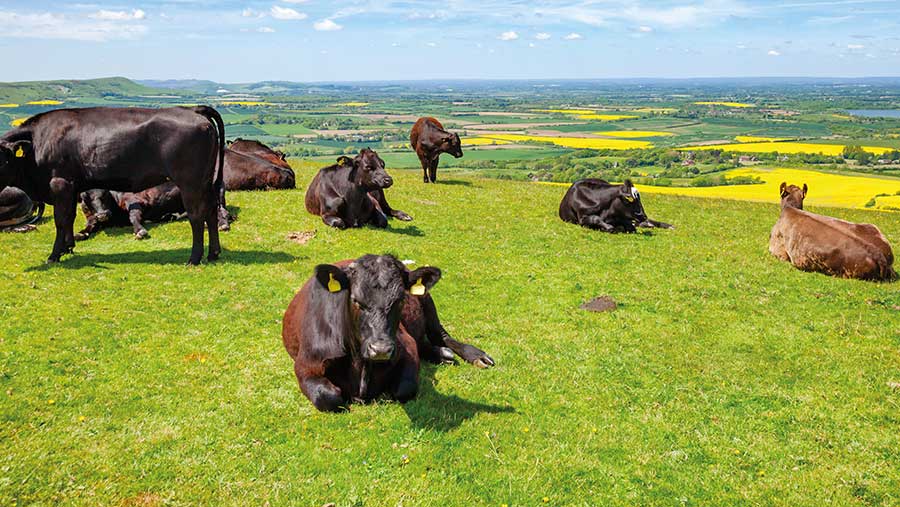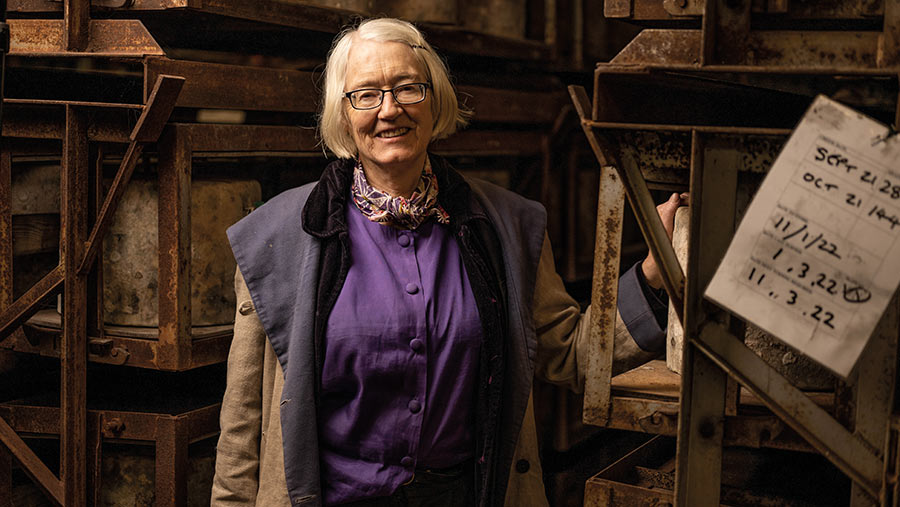British farmers advised to grasp export opportunities
 © Dmitry Naumov/Adobe Stock
© Dmitry Naumov/Adobe Stock Boris Johnson’s government is negotiating new free trade agreements (FTA) at pace with major agri-producing countries, so there has never been a more important time for our farmers to grow their businesses further through exporting.
This crucial message to industry was delivered by NFU president Minette Batters when she addressed farmers, industry stakeholders and politicians at the recent launch of the union’s latest export strategy in London.
The UK agri-food sector contributes about £20bn in food and drink exports each year, but only around 20% of companies sell their goods overseas, according to the UK government, which says it is making extensive efforts to increase this number.
See also: Government must match-fund AHDB cash to grow exports – NFU
Mrs Batters said there were “enormous opportunities” for food and farming businesses to increase exports, but agriculture was “very different to other sectors”.
“I represent 47,000 food and farming businesses and I reckon probably less than 500 are exporting themselves,” she said.
Partnership between governments, farmers, the AHDB and others would be essential to achieve the NFU’s vision, outlined in their Export Strategy April 2022 (PDF), to grow agri-food exports by 30% to more than £30bn by 2030, the NFU chief stressed.
Mrs Batters said the UK government must follow the example of other large agri-food exporting countries, such as Australia and New Zealand, and match-fund the annual £6.6m of AHDB’s levy used to market agri-food exports.
“Ideally, what you want to do is market the hell out of it at home and sell it as far and wide as you possibly can,” she said.
AHDB advice
Phil Hadley, the AHDB’s director of international market development, was present at the NFU’s export strategy launch.
Speaking later to Farmers Weekly, he offered his advice to farmers looking to export their goods.
He said: “First, you need to understand your product and price, and identify its unique selling points.
“You need to learn about the market you are targeting. Where does your product fit in? How does it compete?
“You should consider the greatest opportunities in the marketplace. You might be targeting the foodservice sector, retailers, or another market.
“You should also understand who your competitors are and think about the risks when you enter the market.”
Dr Hadley noted the UK’s strong reputation for food safety and high environmental and animal welfare standards.
Farmers can use this to their advantage, he said, by targeting markets in the US and in Asia where food safety “is a very strong driver for food purchases”.
“For example, in the US you might major on production standards and high welfare as their consumers recognise that meat production is a bit more intensive than in other parts of the world,” he added.
“You might get a bit more traction if you’re selling a high welfare product that is produced without growth promotants or even no antibiotics.”
Livestock farmers could also add value by selling parts of the carcass that do not have a strong market at home, such as offal and fifth quarter cuts of meat, to the Far East.
Dr Hadley said Brexit had added administrative burdens and made it more difficult for farmers to export their products to continental Europe.
Meat and dairy products were subject to stringent checks, increased paperwork, higher trading costs and transportation delays.
“It’s easier to spread the cost of veterinary health certification over a truckload of lamb than a box of cheese,” he noted.
Five steps to export success post Covid and Brexit
- Assess your business Is this the right time for your business to export?
- Do your research Gain an understanding of potential international customers and their customers.
- Raise your profile Build an online presence and create opportunities to embrace change.
- Check your preparations Make sure your business understands the practicalities of exporting, especially post Brexit.
- Grow your exports Think about strategies for growing your exports to embrace change.
Source: AHDB/Department for International Trade/Food and Drink Federation
‘Exports recovering’
The Food and Drink Federation’s (FDF’s) UK Food and Drink Exports report, published earlier this month, reveals that last year exports were recovering from the challenges of the pandemic, and manufacturers are taking advantage of new global trading relationships.
In 2021, Scotland accounted for the lion’s share of UK food and drink exports (almost 30%) worth £5.7bn, up 14.6% since 2020.
In England, the North East saw the largest increase, reaching £280m (up 20.4% on 2020), while the Midlands grew by £810m, a 12.6% rise on 2019 figures.
Wales was the only home nation to exceed pre-Covid export levels – driven by strong exports of cereals – worth £558m to the economy and up 13% on 2019 levels.
The share of exports to non-EU markets was increasing, the FDF said, but the UK government could do more to improve the implementation of the UK-EU trade agreement to help companies recover exports in the EU, as well as grow market share in other global markets. Russia’s invasion of Ukraine was not factored into the report.
Provisional UK government export figures show that the total recorded value of Food, Feed and Drink (FFD) exports in January 2022 was £1.5bn, up 54% on January 2021.
Recorded FFD exports to the EU were double (+101%) those in January 2021. Exports to non-EU countries were 21% higher than January 2021.
Government initiatives
The UK government says it is supporting farmers in a number of ways to enable them to export their products.
The Great Food and Drink campaign, based at Defra, is supporting British food and drink exports through marketing and promotional activity targeted to consumers and trade audiences in four key markets: China, Japan, UAE and the US.
The campaign promotes the industry’s breadth, quality and innovation, and champions its “unique culinary offer to help shift perceptions and support exports”.
Before Easter, the government launched adverts for eight agri-food attachés and counsellors.
The network should be in place later this year, subject to security clearance and relocation conditions, and will be based in India, Thailand, Vietnam, Kenya (with a pan-African remit), the US, Canada, Brazil, and Mexico.
The government has also brought an agri-food attaché for Japan into the network, joining the two existing roles in China and the Gulf.
The Department for International Trade (DIT) and Defra are working with devolved administrations to develop a new food and drinks exports council.
It will strengthen the partnership between government and industry, bringing together agri-food experts to share knowledge, good practice, market intelligence and the capacity to enhance the UK’s global reputation for quality and standards.
Creating export opportunities offered by new FTAs will be a key target.
Defra farm minister Victoria Prentis said: “Our world-class farmers and agri-food businesses are the foundation stone for growing our food and drink exports.
“We want people at home and abroad to be lining up to buy British, and we are working in partnership – government, farmers and industry – to secure greater international trade opportunities.
“We are already transforming our offers to businesses, expanding our agriculture, food and drink attaché network, and establishing a new UK-wide export council.”
Where farmers can get advice and support to boost exports
-
The Department for International Trade’s Export Support Service (tel: 0300 303 8955) can provide support and answers to practical questions, such as exporting to new markets, required paperwork as well as export rules for specific countries
-
Defra’s Great website provides valuable information on how to get started on exports
-
The AHDB’s website provides detailed information, data and advice on how to get into exports
Case study: Quicke’s Cheese, Devon
Fourteenth generation cheesemaker Mary Quicke has been exporting cheese produced at Home Farm, near Exeter, since the 1980s – mainly to the US and Australia.
Mrs Quicke is managing director of Quicke’s Cheese, a family farming and cheesemaking company with 700 cross-bred cows, in a pasture-based grazing system producing milk mainly for traditional farmhouse cheddar and clothbound cheddar cheese.

Mary Quicke © Matt Austin
Export specialists
The farm produces about 200t of cheese a year. Before Brexit and Covid, about 40% was sold to export, but that figure has fallen to just under 25%. Now all the cheese exports are sold via specialist exporting companies due to added complications of paperwork and tariffs.
Mrs Quicke said supplying cheese to retailers in the UK food market could see your product easily displaced if a competitor pitches at a lower price.
But selling some of your product abroad offers farmers an escape route from the “brutal zero-sum gain” of multiple retail.
“I think British farmers may be underestimating the power of taking product off the market and selling it elsewhere,” she added.
Price structure
Mrs Quicke tends to sell her cheese to the exporters for a similar price structure as is sold here.
“On average, we’re getting around £10/kg for our cheese, or £1/litre for the milk equivalent,” she said.
“We’re getting more for our cheese, but there’s more cost involved in making, storing and packing it all,” she said.
“Like everybody, the price of power and labour has gone up, so the extra value doesn’t come free.”
Asked about her advice for farmers interested in starting exports, she said: “First, you need to get a name in this country. You need to resolve supply issues and have packaging that works.
“You must have a product that people want to buy, work out who it is that might want to buy it and identify the overseas markets.
“Then, it’s thinking about the route, how you’re going to distribute your product and ensure you are paid.”
